February 11, 2025: Yesterday’s Court Ruling Underscores Why Trump Actions are Uniquely Harmful
We’ve shared several updates on President Donald Trump and Elon Musk’s campaign to illegally cut taxpayers and communities off from federal funding and reshape the government to promote their interests—with catastrophic results for families whose health care, preschools, and even meals were thrown into limbo.
Last week, Senate Majority Leader John Thune accused the administration’s critics of a “double standard,” alleging that certain Biden administration actions constituted comparable executive overreach. Because these updates aim to make navigating Congress simpler, they don’t often get into the weeds of which laws provide authority for which actions, and so on. However, in this case, it’s worth delving deeper into Thune’s examples and how the Biden administration used its authority in each case. Doing so illustrates just how incomparable the Trump/Musk power grab is—something a court ruling just yesterday underscored. More on that later.
To put the bottom line up top: President Biden exercised his administration’s authority to make education, broadband, and food more affordable. President Trump does not have the authority to take away Americans’ health care, jobs, and more—and is doing it anyway.
What did President Biden do?
Senator Thune cites three examples wherein, he claims, the Biden administration overstepped its authority: 1) issuing student debt relief, 2) implementing the Broadband Equity, Access, and Deployment (BEAD) program, and 3) updating the Thrifty Food Plan (TFP). Here’s a quick rundown on each.
Issuing student debt relief (and complying with court rulings). President Biden attempted to relieve student debt using authority under the 2003 HEROES Act, but the Supreme Court said he couldn’t. The President then sought to use his authority under the Higher Education Act. Yet again, the Supreme Court said no. In both cases, the Biden administration complied with the Court’s ruling.
Implementing the Broadband Equity, Access, and Deployment (BEAD) program. The Infrastructure Investment and Jobs Act (IIJA) created the BEAD program to expand high-speed Internet access nationwide. Senator Thune—who voted against the IIJA—claimed that the Biden administration “made [the program] virtually impossible for anybody to use” by encouraging fair labor practices and affordability when it announced the opportunity for states and territories to apply for BEAD funding. However, as of September, most states’ funding applications had been approved.
Updating the Thrifty Food Plan (TFP). The TFP refers to the grocery budget the Agriculture Department (USDA) uses to determine the monthly Supplemental Nutrition Assistance Program (SNAP, also called food stamps) allotment. Senator Thune accused the Biden administration of “dramatically” changing the program when, at Congress’ direction (see Sec. 4002 of the 2018 Farm Bill), USDA updated the TFP in 2021 for the first time in 15 years. The change meant, on average, an extra $12-$16 per person per month for SNAP households.
What is President Trump doing?
President Trump is impounding—that is, unilaterally withholding—federal funding that Congress has, by law, directed the President to spend for specific purposes. Courts have repeatedly affirmed that the President does not have the authority to do this.
Indeed, yesterday, a judge ruled that the Trump administration must release funds it has continued to keep from communities—and said the administration had violated a previous court order to unfreeze this money.
This is significant for a couple of reasons:
Yesterday’s ruling told the administration to release funds appropriated through the Inflation Reduction Act and the Infrastructure Investment and Jobs Act. The President cut these funds off on his first day in office, withholding communities’ money for road and bridge repairs, flood prevention, broadband expansion, and much more. You can read more about that specific funding freeze in our January 22 update.
This represents the first time a judge has said the administration was failing to comply with a “clear and unambiguous” court order. At the time of writing, the White House hasn’t said whether it will abide by the court’s order while it appeals the decision. Should the President ignore the court’s ruling, it’ll be hard to argue we’re not in a constitutional crisis (but don’t take my word for it).
So, what’s the difference between the two presidents’ actions?
In a nutshell, we’re talking about using the law to lower costs versus breaking the law to raise them.
First: the Biden administration executed the laws Congress passed using the authority Congress granted the President—and when the courts checked that authority, the administration complied. In contrast, the Trump administration is ignoring guardrails the courts have repeatedly placed around presidential authority.
Second: in every example Senator Thune cites, the Biden administration acted to lower Americans’ costs. I raise this not to defend the previous administration, but to contrast the impact the two presidents’ policies have had and will have on families—as this White House’s actions have taken away support to lower the cost of health care, meals, education, and more.
We’ll continue to share analysis on the White House’s actions, Congress’ responses, and—most importantly—the effects on working families across the country.
To get our quick analysis as events unfold on Capitol Hill, sign up for future Unrig the Rules updates here! If you’d like a live update for your group or coalition, reach out to catherine@progressivecaucuscenter.org. Thanks!

